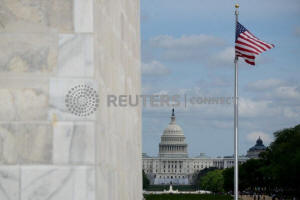Next wave of U.S. states set to reopen as coronavirus could push jobless
rate to 16%
 Send a link to a friend
Send a link to a friend
 [April 27, 2020]
By Nick Brown and Brendan O'Brien [April 27, 2020]
By Nick Brown and Brendan O'Brien
NEW YORK/CHICAGO (Reuters) - Another wave
of states prepared to ease coronavirus restrictions on U.S. commerce
this week, despite health experts warning there is still too little
diagnostic testing, while the White House forecast a staggering jump in
the nation's monthly jobless rate.
Colorado, Mississippi, Minnesota, Montana and Tennessee were set to join
several other states in reopening businesses without the means to screen
systematically for infected people who may be contagious but
asymptomatic, and to trace their contacts with others they might have
exposed.
Many merchants have voiced ambivalence about returning to work absent
the prerequisite public health measures authorities have advocated.
"I would stay home if the government encouraged that, but they're not.
They're saying, 'Hey, the best thing to do is go back to work, even
though it might be risky,'" Royal Rose, 39, owner of a tattoo studio in
Greeley, Colorado, told Reuters.

Rose said she was reopening her shop after closing a month ago, not
because she wants to but because bills are piling up and she feels she
has no choice.
Georgia, Oklahoma, Alaska and South Carolina have already forged ahead
to restart their economies following weeks of mandatory lockdowns that
have thrown nearly one in six American workers out of their jobs.
Public health authorities say increasing human interactions and economic
activity now - without the means to do so safely - will only backfire,
sparking a new surge of infections just as social-distancing measures
appear to be bringing coronavirus outbreaks under control.
Medical experts say strict adherence to business closures and
stay-at-home orders imposed over the past several weeks by governors in
42 of 50 states have worked to level off rates of hospitalizations and
admissions to intensive care units.
Still the number of known U.S. infections climbed higher on Sunday,
topping 960,000 as the number of lives lost to COVID-19, the highly
contagious respiratory illness caused by the virus, surpassed 54,700.
The continuing rise in the number of U.S. cases has been attributed in
part to increased diagnostic screening. But health authorities also warn
that testing and contact tracing must be vastly expanded before
shuttered businesses can be safely reopened on a wide-scale basis.
'TERRIBLE' TOLL ON JOBS
The economic fallout from the unprecedented social distancing
requirements has been devastating.
Business shutdowns have led to a record 26.5 million Americans filing
for unemployment benefits since mid-March. The nonpartisan Congressional
Budget Office predicted on Friday that the economy would contract at an
annual rate of nearly a 40% in the second quarter.
Even next year, the CBO forecast calls for an unemployment rate
averaging above 10%. Before the pandemic struck, the U.S. jobless rate
was hovering at a 50-year low of 3.5%.
White House economic adviser Kevin Hassett told reporters on Sunday the
jobless rate would likely hit 16% or more in April.
[to top of second column]
|

The U.S. Capitol is seen from the Washington Monument, amid the
spread of the coronavirus disease (COVID-19), in Washington, U.S.,
April 25, 2020. REUTERS/Erin Scott

"I think the next couple of months are going to look terrible,"
Hassett said. "You're going to see numbers as bad as anything we've
ever seen before."
Against a backdrop of scattered protests across the country calling
for stay-at-home orders to be lifted, some of the states hardest hit
by the public health crisis were taking a more cautious approach to
economic reopenings.
New York state, the U.S. epicenter of the pandemic, reported 367 new
deaths on Sunday, its lowest loss of life in a single 24-hour span
since March 20, but has extended its business restrictions through
mid-May.
Democratic Governor Andrew Cuomo said construction and manufacturing
would be the first workplaces permitted to reopen and could restart
after May 15 in the upstate region with certain precautions and if
cases continue to decline.
By and large the states forging ahead with reopenings this week are
concentrated in the South, the Midwest and mountain West, where
outbreaks have been far less severe than in the Northeast. Most are
led by Republican governors.
Tennessee said it will allow restaurants to reopen on Monday.
Mississippi's stay-at-home order expires the same day.
Montana, which reported three new cases on Sunday, is allowing
businesses to reopen Monday if they limit capacity and practice
social distancing, while Minnesota is clearing the way for 80,000 to
100,000 workers in industrial and office jobs to return to work on
Monday.
In Colorado, Democratic Governor Jared Polis has given the green
light for retail curbside pickup to begin on Monday. Hair salons,
barbershop and tattoo parlors can open on Friday, with retail
stores, restaurants and movie theaters to follow.

Even within states, the lifting of restrictions may vary from place
to place. Denver, for example, extended stay-at-home orders to May 8
but city dwellers can drive to a nearby county for a haircut.
Georgia, on the other hand, has prohibited any local measures
stricter than the state orders.
Eight states never ordered residents to stay at home -- Arkansas,
Iowa, Nebraska, North Dakota, Oklahoma, South Dakota, Utah and
Wyoming.
Opinion polls have generally shown a bipartisan majority of
Americans want to remain at home to protect themselves from the
coronavirus, despite the impact to the economy.
(Reporting by Nick Brown in New York and Brendan O'Brien in Chicago;
Additional reporting by Tim Ahmann in Washington and Maria Caspani
in New York; Writing by Lisa Shumaker and Steve Gorman; Editing by
Daniel Wallis)
[© 2020 Thomson Reuters. All rights
reserved.] Copyright 2020 Reuters. All rights reserved. This material may not be published,
broadcast, rewritten or redistributed.
Thompson Reuters is solely responsible for this content. |